-

人教版新目标初中英语八年级下册Why don’t you get her a scarf教案
教师带领学生复习有关描述宠物的词汇,采用教师提问学生回答的方进行。如:T:What animals do you think would be good pets?What animals do you think would be bad pets?What do you think are good animals for a six-year-old child?然后学生进行 pairwork 练习。Task two: 师生互动,学习探究 1、播放3a部分的录音,引导学生一边听录音,一边跟读。2、通过听录音学生回答以下问题:Why do you think pot-bellied pigs are popular?What are the advantages and disadvantages of keeping such a pet?教师对学生的回答进行及时点评。3.学习范文,学习重点短语,为下步的模仿写作提供语言素材。T :1. )Have you ever kept a pig as a pet?Do you like pigs? St.:No.…Why don’t you like to keep a pig? St: No.They’re too dirty and lazy(Do you know in some foreign countries like Hollyland, Australia,pigs are the most popular pet.there’s a kind of pig.(图)it has an interesting name? it ‘s called a pot-bellied pig.) Now,let’s learn an article about this kind of interesting pet.2.)play the tapeSt.:Listen and repeat3.)show some Qs on computer(本子St.: read silently,then answerthe Qs(本子)4.)Ask ss. Close book and retell this passage.(what is a pot-bellied pig? Is it a good or bad pet? ) St.: retell it to each other“A pot –bellied pig is a popular pet now…”5.read the article together.St.:.practice reading

人教版新目标初中英语八年级下册Would you mind turning down the music教案
Step 4. Group work (4)1. Ask a pair of students to read the dialogue. Say, This activity provides speaking, listening and writing practice using the target language.2. Ask students to complete the work in groups.3. Check the answers with the whole class. 4. Explain some of the language points. Step 5. Word review (Self check 1)1. Ask students to read the words and the phrases given. 2. Fill in the blanks with proper forms of these words to complete the sentences. 3. Check the answers with the whole class. Homework:Do activity 2 on page 57 after class. Period 6Teaching aims: 1. Teach vocabulary words and the useful expressions. 2. Enable the students to learn etiquette in different culture. 3. Help the students learn how to behave politely in public places and in daily life. Teaching procedures:Step 1. RevisionHelp students to review the function of making requests through a free talk. Then lead them to the topic of etiquette. Explain the meaning of etiquette. Or, ask students to look it up in the dictionary. Step 2. Pre-reading (Section 1)1. Ask students to read the picture and make a list with their partner about how many rules of etiquette can be seen being broken.
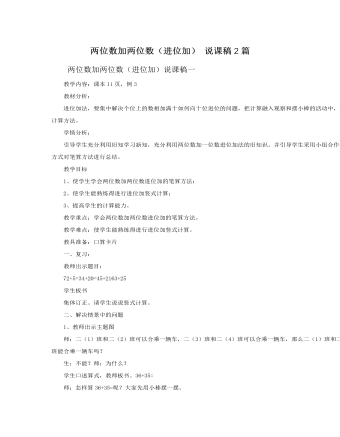
人教版新课标小学数学二年级上册两位数加两位数(进位加) 说课稿2篇
一、说教材:本课时主要的内容就是让学生在情境中掌握两位数加两位数的进位加法计算,让学生通过尝试和探索出多种算法,体验多种算法,然后比较出最好的算法。教学目标:1、通过具体的情境使学生更一步的理解加法的意义和提高学生的估算意识。2、通过学生的合作学习从而能探讨出多种计算两位数减两位退位减法的方法。3、培养学生的数学口语表达能力,提高学生的学习兴趣。4、掌握两位数加两位数(进位加)竖式的写法。重点:(1)通过学生的合作学习从而能探讨出多种计算两位数减两位退位减法的方法。(2)掌握笔算加法的计算法则。难点:对多样化算法进行优化,达到正确完成计算。发展学生的估算意识、和探究意识和解决实际问题的能力。二、说教法:组织学生在前面计算的基础上,自主探索出两位数加两位(进位加)的计算方法,并通过交流、讨论,达到对算法的优化,在通过“试一试”、“算一算”、“想一想”等形式达到知识的掌握。
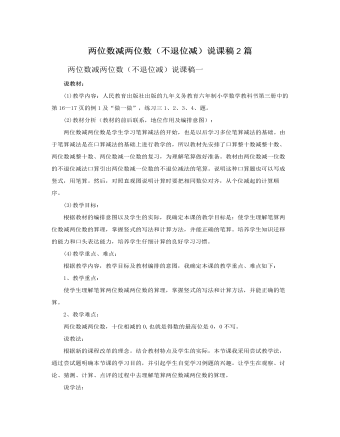
人教版新课标小学数学二年级上册两位数减两位数(不退位减)说课稿2篇
说教材:(1)教学内容:人民教育出版社出版的九年义务教育六年制小学数学教科书第三册中的第16—17页的例1及“做一做”,练习三1、2、3、4、题。(2)教材分析(教材的前后联系,地位作用及编排意图):两位数减两位数是学生学习笔算减法的开始,也是以后学习多位笔算减法的基础。由于笔算减法是在口算减法的基础上进行教学的,所以教材先安排了口算整十数减整十数、两位数减整十数、两位数减一位数的复习,为理解笔算做好准备。教材由两位数减一位数的不退位减法口算引出两位数减一位数的不退位减法的笔算。说明这种口算题也可以写成竖式,用笔算。然后,对照直观图说明计算时要把相同数位对齐,从个位减起的计算顺序。(3)教学目标:根据教材的编排意图以及学生的实际,我确定本课的教学目标是:使学生理解笔算两位数减两位数的算理,掌握竖式的写法和计算方法,并能正确的笔算。培养学生知识迁移的能力和口头表达能力,培养学生仔细计算的良好学习习惯。
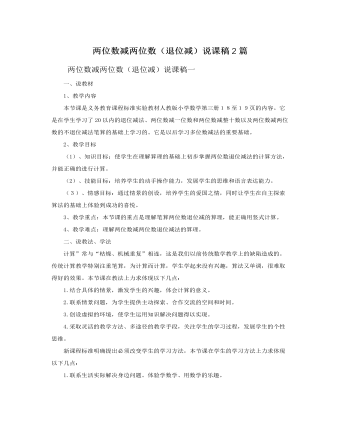
人教版新课标小学数学二年级上册两位数减两位数(退位减)说课稿2篇
一、说教材1、教学内容本节课是义务教育课程标准实验教材人教版小学数学第三册18至19页的内容。它是在学生学习了20以内的退位减法、两位数减一位数和两位数减整十数以及两位数减两位数的不退位减法笔算的基础上学习的。它是以后学习多位数减法的重要基础。2、教学目标(1)、知识目标:使学生在理解算理的基础上初步掌握两位数退位减法的计算方法,并能正确的进行计算。(2)、技能目标:培养学生的动手操作能力,发展学生的思维和语言表达能力。(3)、情感目标:通过情景的创设,培养学生的爱国之情,同时让学生在自主探索算法的基础上体验到成功的喜悦。3、教学重点:本节课的重点是理解笔算两位数退位减的算理,能正确用竖式计算。4、教学难点:理解两位数减两位数退位减法的算理。
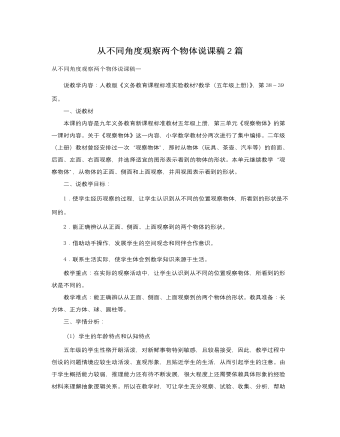
人教版新课标小学数学五年级上册从不同角度观察两个物体说课稿2篇
自主探究法:教学中强调以学生为主体,强调学生参与知识的形成过程,始终做到为学生提供充足的学习素材、创设充分学习的空间、时间,让学生自主探究,体验知识形成的过程,培养主动探究的能力。观察法:例1观察物体教学中的观察是很好的学习方法。例如,教学例1时,观察目的明确。教师通过让学生观察长方体物体学会从不同角度观察物体的方法。这一安排不仅给学生独立思考的机会,而且教给学生观察的思维方法。四、说教学程序在提出问题中,引发学生思考;在自主探索中,激发学生创新思维;在展示交流中,感受学生的个性;在总结陈述中,体验成功的乐趣;在联想记忆中进一步发挥学生的创造才能。在设计这节课时,我在尊重教材的基础上,力求体现新课标的新理念、新思想,导学案中设计了以下几个教学环节:
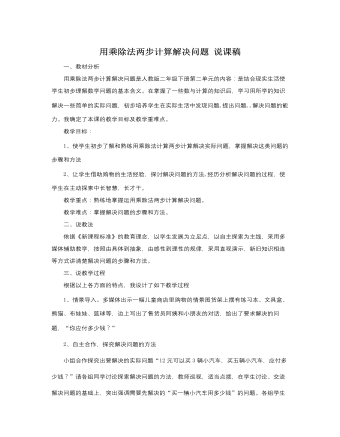
人教版新课标小学数学二年级下册用乘除法两步计算解决问题说课稿
例2是面包房买卖面包的情境。解决问题的重点是学会使用小括号列综合算式,并了解小括号的作用。通过学生熟悉的购买面包的情境,解决“还剩多少个”这个实际问题。仍然可以引导学生从不同的角度思考问题,启发列式为54-8-22或为54-(8+22)。第二种解法的综合算式,教材中特别强调“如果写成一个算式,应该使用小括号”,并明确“计算时先算小括号里面的”。因为是初次在列式时需要使用小括号,如果学生产生疑问,教师可组织学生通过回顾旧知,利用现实情境,明确使用小括号的必要性及使用方法。教学例2时可以采用与例1相似的教学方式。首先让学生观察下页图,也可以利用电教媒体创设情境,由学生提出问题,并启发学生思考如何解决。让学生充分交流研讨,畅谈自己的想法,然后着重说明解决问题的思路。列式计算时可以先分步列式,同时强调两种列式方法的内在联系,列综合算式时着重说明使用小括号的目的。
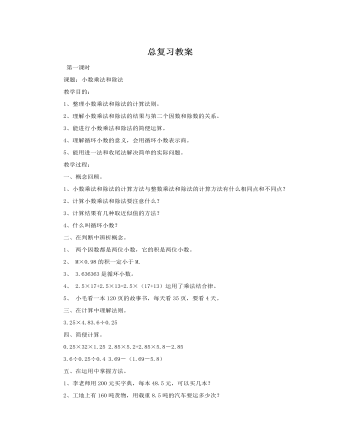
人教版新课标小学数学五年级上册总复习教案
(4)学校买10套课桌用500元,已知桌子的单价是凳子的4倍,每张桌子多少元?三、作业。第四课时课题:可能性和编码复习目标:1、认识简单的可能性事件。2、会求简单事件发生的可能性,并用分数表示。3、通过日常生活中的一些事例,使学生初步体会数字编码思想在解决实际问题中的应用。4、让学生学会运用数进行编码,初步培养学生的抽象、概括能力。一、基本练习。1、盒子中有红、白、黄、绿四种颜色的球各一个,只取一次,拿出红色球的可能性是多少?白色呢?2、商场促销,将奖品放置于1到10号的罐子里,幸运顾客有一次猜奖机会,一位顾客猜中得奖的可能性是多少?3、盒子中有红色球8个,蓝色球10个,取一次,取出红色球的可能性大还是蓝色球?4、说出下面各组数据的中位数。
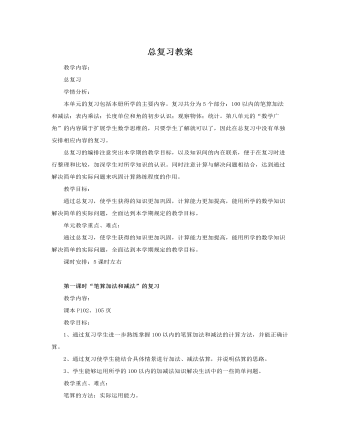
人教版新课标小学数学二年级上册总复习教案
教学内容:课本P104、108页。教学目标:1、通过复习使学生加深了解统计的意义。2、巩固学生对条形统计图的认知,明确用1格表示2个单位的表现形式,能根据统计图提出问题。3、在学习过程中培养学生的实践能力与合作意识。教学重点、难点:1、在复习中进一步了解统计的意义,加深对条形统计图的认识。2、能根据条形统计图的条件提出数学问题。教学过程:一、复习统计1、观察讨论(1)、教师出示条形统计图:这张图叫什么名字?它有什么作用?仔细观察统计图你有哪些发现?(2)、学生观察讨论,思考,依据自己的体验回答。仔细观察统计图,在小组内交流自己的发现。(3)、组织全班汇报交流,梳理统计图信息。2、回答问题根据条形统计图上的信息,你能回答下列问题吗?1)、最受二年级同学欢迎的饮料是什么?你是怎么看出来的?2)、喜欢哪两种饮料的人数同样多?你是怎么知道的?
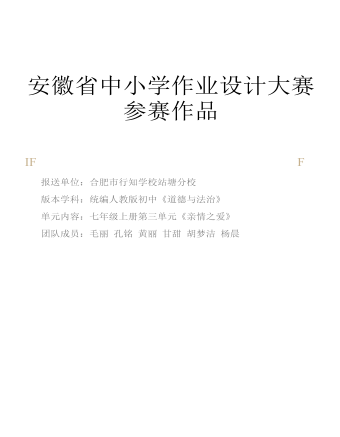
初中道德与法治七年级上册亲情之爱作业设计
2. 内容内在逻辑本单元亲子之间的交往既承接了上一课的“师生之间”的交往,也为七年级 下册关于中学生提升在集体中的交往水平和能力奠定了坚实的基础,因此本单元 在教材中起承上启下的作用。第一框“家的意味”,通过对“家规” “家训”的探究,引出中国家庭文化中“孝”的精神内涵,引导学生对家庭美德进行深入思考,学会孝亲敬长。第二框“爱在家人间”,通过体验家人间的亲情之爱,进而引导学生感受对 家人割舍不断的情感。第三框“让家更美好”,通过对传统家庭与现代家庭的比较,引导学生认识 现代家庭的特点,树立共创共享家庭美德的意识,共创和谐美德之家。从初识家中“孝”,体验家中“爱”,处理家中“冲突”,到自觉共建家庭 “美德”,学生逐步体味亲情之爱,将“亲情之爱”内化于心、夕卜化于行。(三)学情分析(1) 认知水平与心理特点七年级学生正处于青春期,是生理和心理急剧变化的关键时期,自我意识不 断增强,逆反心理更加强烈,情绪波动较大。
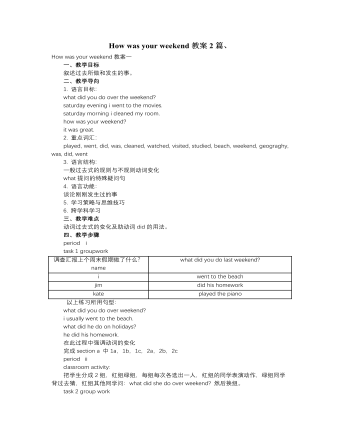
人教版新目标初中英语七年级下册How was your weekend教案2篇
Teaching Goal:1. General aims:Talk about recent past events2. Particular aims:A. Language Focus.Talk about recent past events and think of the past events.B. Language goalsHow was….?It was …What did …do over the weekend?C. Language structures:(1). How was your weekend? I was great. Pay attention to no form.(2). What did you do over the weekend? I played soccer. We went to the beach.D. Useful words and phrases:Words: was, did, went, beach, over, project, test, wasn’t, false, number, geography, spend, week, most, mixture, their, had, little, cook, read, saw, change, everyone, sit, sat, no, anythingPhrases: did one’s homework, played soccer, cleaned my room, went to the beach, played tennis, went to the movies, on Saturday morning, over the weekend, cook … for, what about, do some reading, have a party, talk show, go shoppingE. Grammar language:Present simple past tenseRegular and irregular verbsF. Learning strategies:Tour and holidaysG. Interdiscipinary:H. Emotion and manner:Teaching time: 5 periodsTeaching procedures:Period One教学步骤、时间 教师活动 学生活动 媒体应用Step 1Free talk 3’ Ask some questions like:Who’s on duty today?What’s the weather like? Answer and talk about something.让同学们回答下列问题1. Do you like weekend? (Let some students answer)It takes them three minutes to talk about the question.2. Why do you like weekend? (let the students answer) Most of the students like the weekend此时教师用汉语问:“在周末期间问你干了什么?这句话用英语这么回答?Let the students guess.At last the teacher give them right answer3. What did you do over the weekend?(板书、学习)
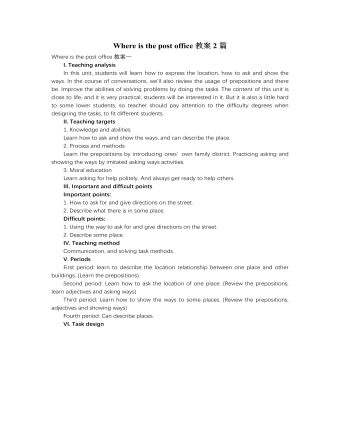
人教版新目标初中英语七年级下册Where is the post office教案2篇
Period 2 (3a----Section B 2c)Preview(Pre-task): Key points: What laAdd another information about their pen pals----their language on the cardnguage does she/he speak?She/He speaks....Does she/he have any brothers and sisters? Does she/he speak English?Preview(Pre-task): Add another information about their pen pals----their language on the cardKey points: What language does she/he speak?She/He speaks....Does she/he have any brothers and sisters? Does she/he speak English?Step 1 Revision1.Revisionand dictation of the new words 2.Revise the drills they learned yesterday.(by pairwork and grammar exercise)Step 2 Leading-inT has a conversation with one student. The conversation is following:---Do you have a pen pal?---Yes, I do.---What's your pen pal's name? ---His/Her name is....---Where is your pen pal from? ---He/She is from...---Where does he/she live? ---He/She lives in....---What language does he/she speak?He/She speaks...Write the new words on the Bb. They are following: EnglishChineseJapaneseFrenchStep 3 LearnLearn the new words with the whole class.Finish 3a with the students3b Pairwork T still does an example with one student Then the Ss practise in pairs. The example is following:--Curry Muray is my pen pal. He is from the United States.---What language does he speak?
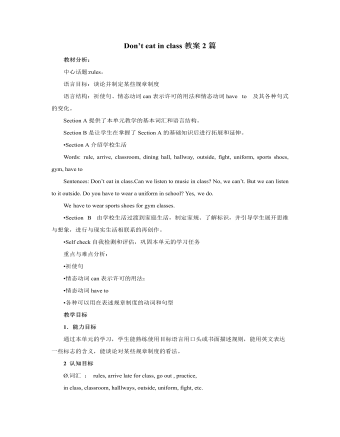
人教版新目标初中英语七年级下册Don’t eat in class教案2篇
Don’t fight. =You can’t fight. (板书,教读)教师把这些句子板书在黑板上,并请学生大声整齐地读祈使句和“can’t”句型,并让学生注意两种句型表达形式的不同和转换,“Don’t …=You can’t…”;并对学生说:These are our school rules. (板书,教读) You can’t break the school rules. Don’t break the school rules.(板书,教读)步骤3 :Practicea. T: Now, each of the students is breaking one of these rules.Please finish 1a.学生看图,完成1a的内容,检查答案并大声朗读校规。b. 听录音,完成1b,选出四位学生都违反了哪条校规;听之前,学生要读会英文名。c. 请两位学生朗读1c部分的句型;要求学生两人一组对话表演,SA扮演外校转来新生,SB告知本校校规。(学生可经过讨论,多说出他们想到的校规,不必只限于书上;教师应给予帮助)2) 第二课时(2a~4)步骤1 :warming up of revisionT: What are the rules at your school?学生使用“can”或祈使句表达各条校规;其中老师可引出“eat in the cafeteria outside”的表达。步骤2 :Practicea.T: Christina is an exchange student. She doesn’t know the rules. Let’s listen, what activities they’re talking about?学生听第一遍时,完成2a;第二遍时,完成2b;b. 请学生领读2c部分,看着2a完成的表格,理解2c活动的要求;分成小组针对2a进行问答;
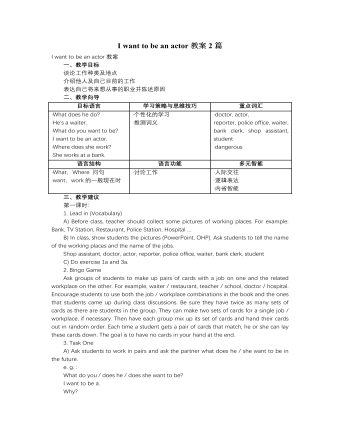
人教版新目标初中英语七年级下册I want to be an actor教案2篇
三、教学建议第一课时:1. Lead in (Vocabulary)A) Before class, teacher should collect some pictures of working places. For example: Bank, TV Station, Restaurant, Police Station, Hospital ...B) In class, show students the pictures (PowerPoint, OHP). Ask students to tell the name of the working places and the name of the jobs.Shop assistant, doctor, actor, reporter, police office, waiter, bank clerk, studentC) Do exercise 1a and 3a.2. Bingo GameAsk groups of students to make up pairs of cards with a job on one and the related workplace on the other. For example, waiter / restaurant, teacher / school, doctor / hospital. Encourage students to use both the job / workplace combinations in the book and the ones that students came up during class discussions. Be sure they have twice as many sets of cards as there are students in the group. They can make two sets of cards for a single job / workplace, if necessary. Then have each group mix up its set of cards and hand their cards out in random order. Each time a student gets a pair of cards that match, he or she can lay these cards down. The goal is to have no cards in your hand at the end.3. Task OneA) Ask students to work in pairs and ask the partner what does he / she want to be in the future.e. g. :What do you / does he / does she want to be?I want to be a.Why?Because it's (adj).B) Vocabulary: Section B, 1a4. Homework 1.2.
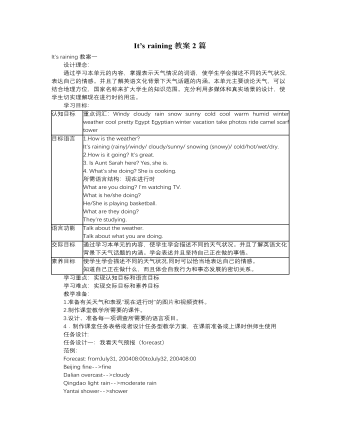
人教版新目标初中英语七年级下册It’s raining教案2篇
1 Each group choose one place to describe and what you are doing in it Choose one place, and describe what they are doing 2 Move around the room and give suggestions Talk about it and write it down 3 Ask one to show their works and act it Choose one of each group to make a report 4 Evaluate the best group and the best reporter Choose the best one Homework Ask your friends their ideal place and write about it教学反思:新课程标准中强调学生在课堂中的主体地位,在综合课中他们的主体地位就更加突出。在各个活动中给不同程度的学生不同层次的任务,让各层面的学生都有表现发挥的机会,从而产生对英语的兴趣。使用照片图片多媒体来辅助教学,效果更好。同时让了解其他国家风景,风俗的同学介绍ideal place,增加学生的背景知知识,实现跨学科交流的目的。教案点评:采用任务型教学模式,在各个活动中给不同程度的学生不同层次的任务,让各层面的学生都有表现发挥的机会,从而产生对英语的兴趣。使用照片图片多媒体来辅助教学,效果更好。让了解其他国家风景,风俗的同学介绍ideal place,增加学生的背景知识,实现跨学科交流的目的。
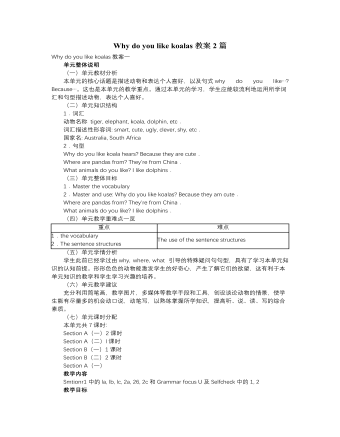
人教版新目标初中英语七年级下册Why do you like koalas教案2篇
单元整体说明(一)单元教材分析本单元的核心话题是描述动物和表达个人喜好,以及句式why do you like…? Because…。这也是本单元的教学重点。通过本单元的学习,学生应能较流利地运用所学词汇和句型描述动物,表达个人喜好。(二)单元知识结构1.词汇动物名称 tiger, elephant, koala, dolphin, etc.词汇描述性形容词: smart, cute, ugly, clever, shy, etc.国家名: Australia, South Africa2.句型Why do you like koala hears? Because they are cute.Where are pandas from? They're from China.What animals do you like? I like dolphins.(三)单元整体目标1.Master the vocabulary2.Master and use: Why do you like koalas? Because they am cute.Where are pandas from? They're from China.What animals do you like? I like dolphins.(四)单元教学重难点一览(五)单元学情分析学生此前已经学过由why, where, what 引导的特殊疑问句句型,具有了学习本单元知识的认知前提。形形色色的动物能激发学生的好奇心,产生了解它们的欲望,这有利于本单元知识的教学和学生学习兴趣的培养。
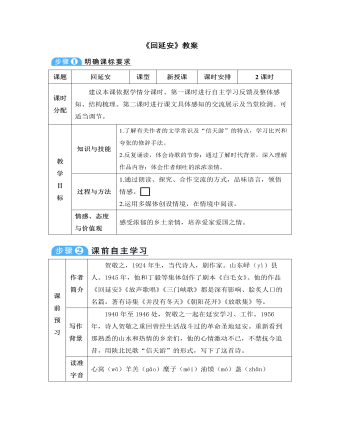
部编版语文八年级下册《回延安》教案
【初读课文,整体感知】1.诗歌共分为五小节,这五小节分别写了什么内容?第一小节:阔别十年重回延安;第二小节:追忆当年战斗生活;第三小节:亲人相见话延安;第四小节:喜看延安今繁华;第五小节:颂延安光辉历史。2.试想想诗人写作这首诗抒发思想情感的线索是什么?讨论、明确:全诗以诗人离别10年后重返延安的所见所闻所想为线索。【细读课文,仔细品味】1.作者在第一节中是怎样通过一系列动词表现情感的?“抓”“贴”等逼真的动作,表现了诗人回到延安时的激动情景。“双手搂定宝塔山”的“搂”字,写尽了作者对延安的怀念。“唱”“笑”“招”具有拟人的色彩,渲染了欢乐的气氛。最后一个“扑”字,强烈、准确地表达出作者的想念。2.第二节中,“二十里铺送过柳林铺迎,分别十年又回家中”在结构上有什么作用?
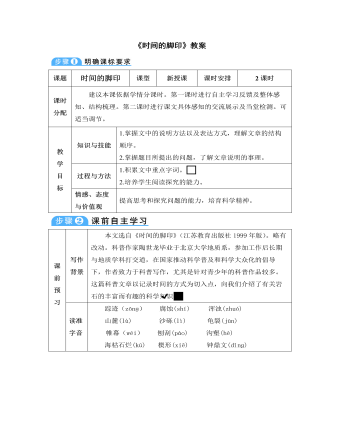
部编版语文八年级下册《时间的脚印》教案
【初读课文,整体感知】1. 以《时间的脚印》为题目有什么好处?文章的题目《时间的脚印》,是从高士其《时间伯伯》一诗中引申借用来的。其拟人化手法的运用,形象地说明了那些形形色色、大大小小的岩石中都潜藏着时间的踪影,以引起人们的探究欲望和阅读兴趣。【再读课文,梳理结构】1.第一部分(第1至第4自然段)说明岩石“是记录时间的方式中最重要的一种”。2.第二部分(第5至第29自然段)分层次地详细说明岩石是怎样记录时间的。这部分分三层。3.第三部分(第30自然段至全文完)总结全文,说明岩石记录时间的意义,号召人们进一步去大自然找寻时间的踪影,去一步步走向地下的宝库。【感悟精彩句子】1.“狂风来了,洪水来了,冰河爬来了”。
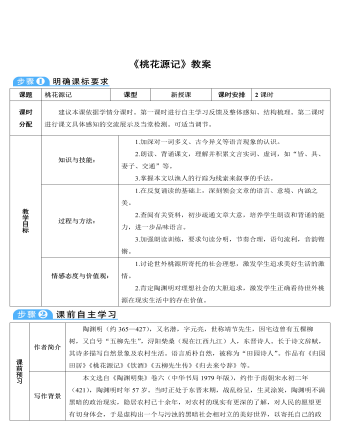
部编版语文八年级下册《桃花源记》教案
首先,我让学生结合书下注释,自行朗读课文。在读准字音的基础上,由老师带感情朗读,配合优美的乐曲,一下子便把学生带到课文的意境中,然后再由学生仿读,边读边体会,读中导,读中悟。接着,给学生自主学习的空间。我要求同学们凭借下面的注释,结合语境翻译课文,然后小组自主探究,最后小组提出疑难点,教师在班上引导学生解决,并把文言实词虚词归类。三、反复诵读,品味佳句,突破重难点。如果说前面的读是在为品做准备,那么真正的品就在学生对文章优美佳句的欣赏上,要求学生仔细品味自认为文中写得好的语句。这一环节我首先让学生自行找出自己喜爱的地方,然后说明喜爱的原因。这既是一种对课文的理解,又是一种知识的迁移。
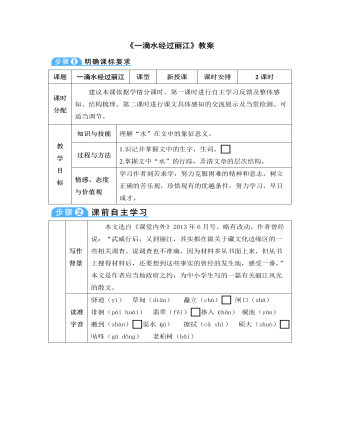
部编版语文八年级下册《一滴水经过丽江》教案
【感悟精彩句子】1. “今天,一架大水车来把我们扬到高处,游览古城的人要把这水车和清凉的水作一个美丽的背景摄影留念。”写到大水车的用意是什么? 大水车是丽江古城的标志性建筑,成为了丽江古城的地标,也是游客们一定要去拍照留念的地方。历史足迹明显,地域特色突出。2. 一些薄云掠过月亮时,就像丽江古城中,一个银匠,正在擦拭一只硕大的银盘。联想,古城的民俗难以忘怀。3.“我知道,作为一滴水,我终于以水的方式走过了丽江。”这样的结尾,体现了一滴水怎样的情怀?〖ZK)〗欣赏了风景如画的丽江,考察了“土”味浓郁的建筑,体会了丰富多彩的民俗民风,美感袭身,皆满足矣。融入更加广阔的江海,开始一滴水热情、奔放的新生活。